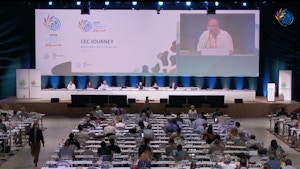Indonesia has cut back its planned transfer of state forests to local communities this year by half - an area twice the size of Los Angeles - because of the coronavirus outbreak, according to the Ministry of Environment and Forestry.
Bambang Supriyanto, the ministry’s director general of social forestry and environmental partnership, said social distancing measures from March to June had halted the technical work needed on the ground to certify the handover of land.
The pandemic will see this year’s target of 500,000 hectares (about 1.2 million acres) reduced by 50 per cent, he told the Thomson Reuters Foundation.
In 2014, President Joko Widodo pledged to hand over 12.7 million hectares of state forests to rural communities within five years, an ambitious bid to resolve intractable land conflicts while helping curb planet-warming emissions.
Although the 2019 deadline was missed, the government is working to speed things up, but the pandemic has hampered efforts this year.
The social forestry programme is also intended to tackle rural poverty by establishing thousands of forest enterprises, ranging from eco-tourism ventures to sustainable management of forest products such as bamboo and rattan.
Agriculture and forestry accounted for more than a third of national income in 2014, but poverty among those living in or near forests exceeded the national average.
Meeting the target would see community management of forests rise from about 1 per cent of Indonesia’s forest estate to more than 10 per cent.
“Whether it was only a leap of faith, Jokowi’s decision was remarkable,” said Delia Catacutan, Southeast Asia coordinator at the World Agroforestry Centre.
“Critics and spectators were sceptical the government would be able to do it in the first place.”
New rules to speed up implementation were introduced in 2016, cutting out local governments and enabling communities to apply directly to the central government to manage land.
A working group established in 2017 brought academia, non-profit groups and government offices together to support communities in the application process.
“
It takes time to transform local communities into entrepreneurs.
Delia Catacutan, Southeast Asia coordinator, World Agroforestry Centre
Transferring land to communities progressed slowly at first, with just over 1 million hectares authorised for community management by 2017.
However, the ministry accelerated the community forestry programme in 2018 with higher funding and trimmed red tape.
The latest government data show the transfer of 4.2 million hectares had been authorised by late June this year, almost a third of the original target.
“In the bigger scheme of things, the 4.2 million hectares of licensed land presents significant progress given the tumultuous land conflict in Indonesia,” noted Catacutan.
Cutting emissions
This May, the ministry authorised a 9,480-hectare area of customary land for the Dayak Iban indigenous group in Borneo.
That was the largest-ever recognition of an indigenous community’s customary land, according to Yuli Prasetyo Nugroho, head of the ministry’s indigenous forest and customary knowledge section.
In mid-July, as coronavirus restrictions eased, some forestry staff returned to work in the field in rural areas with low virus transmission rates, said Supriyanto.
Total land authorised under Indonesia’s social forestry programme could reach close to 5 million hectares by the end of 2021, according to the ministry’s updated plans.
By giving local communities a direct stake in the landscape, the programme aims to soothe conflict, cut carbon emissions by slowing deforestation, nurture biodiversity and boost incomes.
Conversion of forest land for agriculture and other economic purposes, which fuels peatland fires and destroys mangroves, accounts for about two-thirds of Indonesia’s greenhouse gas emissions.
Indonesia’s national climate action plan, submitted to the United Nations, pledges to reduce emissions by 29-41 per cent from business-as-usual levels by 2030.
But the contribution social forestry could make to meeting that target needs to be studied further, said Arief Wijaya, senior manager of climate, forests and oceans at the World Resources Institute in Indonesia.
“Our recent analysis over social forestry areas in Indonesia shows that partly there is reduced deforestation in (those) areas,” he said.
Nonetheless, some forestry scientists are concerned that not all communities will have the capacity to implement the land management plan agreed with the government.
Community forestry programmes in the Philippines, for example, have lacked the technical support services needed to make them successful in the long term.
Some Indonesian communities may also struggle to manage their land as a sustainable enterprise, experts fear.
Management plans often require communities to work with the ministries for small business and trade, which adds complexity.
“It takes time to transform local communities into entrepreneurs,” said the World Agroforestry Centre’s Catacutan.
This story was published with permission from Thomson Reuters Foundation, the charitable arm of Thomson Reuters, that covers humanitarian news, climate change, resilience, women’s rights, trafficking and property rights. Visit http://news.trust.org/climate.





















